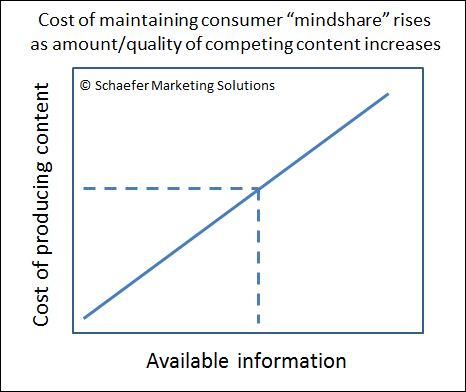There is a fundamental reality of the social web that is slowly killing your marketing strategy, whether you know it or not: The Physics of Social Media.
Now, don’t freak out. It’s not complicated or boring, and it makes no mention of black holes or the Higgs Boson. It’s a pretty simple but important idea about the increasing demands on your content and marketing messages. Let’s look at the two colliding factors that will dramatically impact your marketing initiatives.
1) The amount of available information is accelerating. I recently saw an infographic reporting that all of the information created in the past two years equals the amount of recorded information for all of human history. Is that true? I don’t know. I make up most of my statistics any way, but it sounds about right. The point is, we are in a permanent state of information overload and it’s going to get much, much worse.

In the physical world, this is what happens when you try to push too much stuff though a finite pipeline — catastrophic failure. A flood. Wires bursting into flame. Server crashes.
So this presents the fundamental dilemma for you and me. How do we get our marketing message to cut through the infinite information and make it through to a consumer brain — without going broke or having a catastrophic strategic failure?
We’ve never faced this before
This is a relatively new problem. Even in the early days of mass broadcasting, getting your message through was easy. You simply bought advertisements on the most popular radio and television programs. Those days are coming to an end. Nielsen reported that in 2011, the number of hours that Americans viewed TV declined for the first time in the history of television. Newspaper advertising, adjusted for inflation, is down to 1950s levels. Even website visitors are down. In the past two years, 68% of the Fortune 500 companies had a drop in unique visitors to their company websites.
So we have no choice. Day by day, every single company in the world is realizing that it must join this social media battle for consumer mindshare. And that war is raging though web-based content.
If you are comfortable with your content marketing strategy, don’t be. The game is about to become vastly more difficult and if you just keep on doing what you’re doing, you are slowly going to get wiped out.
Three ways to maintain content mindshare
How do you fend for your piece of your customer’s mindshare in the face of this information tsunami? There are only three possible strategies:
1) Maintain mindshare through increasingly spectacular content. This is the classic — but theoretically unsustainable — content marketing strategy: Offer amazing content that will make people want to spend time with you. But the cost of maintaining this quality level is inexorably going up. So this approach will inevitably stall as costs rise and companies discover the finite economic value of loyalty.
2) Maintain “mindshare” with less pipeline. If the cost of maintaining mindshare is going to keep going up (and it will), another idea is to find a way to push out the same amount of value through less time with your content. This would explain the meteoric rise of content aggregation, infographics, and visually-oriented sites like Pinterest and Instagram. People don’t have to read. They are capturing information quickly and moving on to the next item in the pipeline. I think it is safe to predict that we are just at the beginning of this trend. Free advice: Invent social media platforms to expose more information in less time and you will become rich.
3) Infiltrate other content with your message. This is like a Trojan Horse. When a consumer opens up somebody else’s content they find you. The idea is that you let other content providers bear the huge cost of maintaining mindshare and you sneak in. Examples:
- Guest posts on popular sites
- Influencer outreach — Nurturing relationships with high-impact influencers willing to share and validate your content
- News-jacking — Establishing a voice of authority so that the news channels come to you.
- Brandscaping — Sharing space with other, related brands
- PR — Methodically finding opportunities to place content in big “pipelines”
I would suggest that a successful long-term social media marketing strategy must have at least parts of all three of these, in addition to an aggressive network building strategy.
If you made it this far, thank you. I know this is heavy stuff and I appreciate your patience with the explanation. What do you think? Are you starting to feel the crunch? What are your ideas on how a marketer can prepare for this next phase of competition? Or, do you think I’m wrong?
Illustration: BigStock.com



